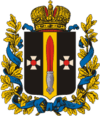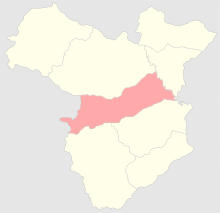Dzhevanshirsky Uyezd
Dzhevanshirsky Uyezd (Russian: Джеванширский уезд) also spelled as Jevanshir Uyezd, was one of the uyezds (administrative divisions) of Elisabethpol Governorate of the Russian Empire, with its center in Tartar in 1869–1918.[1]
Dzhevanshirsky Uyezd Джеванширский уезд | |
|---|---|
 Coat of arms | |
 | |
| Country | Russia |
| Political status | Uyezd |
| Region | Caucasus |
| Established | 1869 |
| Abolished | 1918 |
| Area | |
| • Total | 5,483 km2 (2,117 sq mi) |
| Population (1897) | |
| • Total | 72,719 |
| • Density | 13/km2 (34/sq mi) |
Geography
Elisabethpol Governorate consisted of Yelizavetpolsky, Nukhisky, Shusha, Zangezur, Kazakh, Aresh, Dzhebrailsky and Dzhevanshirsky Uyezds[2] Javanshir Uyezd was made up of two parts: the northeastern lowland and southwestern mountainous part of Jraberd. The area covered 4,818.4 square verst.[3] The lower part, called Arran was hot and dry during summers which made the inhabitants move to mountainous areas for the duration of season. The winters were mild and short. The middle part of the uyezd is located on the hills and is enriched with forests. The southern part is located high in the mountains. The highest peaks in mountainous ranges stretching from Gokcha are Murovdag (11,219 ft), Gozeldere-bashi (11,606 ft) and Ginal-dag (11,057 ft). A big part of Javanshir Uyezd is within the Tartarchay basin, which starts high in the mountains near the border with Novobayazidsky and Zangezursky Uyezds and flows through uyezd discharging into Kura. The importance of the river is high as it was used for irrigations means in Javanshir as well as Yelizavetpolsky and Shushinsky Uyezds.
The administrative center of the uyezd was Tartar, located on the Elisabethpol-Shusha road, about 681.6 verst from Elisabethpol.[4]
History
The territory of Javanshir and Jabrayil uyezds was a part of Karabakh Khanate. In 1869, it was created out of a northern part of Shusha Uyezd. After the Russian Empire ceased to exist and Azerbaijan Democratic Republic was founded in 1918, Shusha, Javanshir, Jabrayil and Zangezur uyezds became a part of Azerbaijani-Armenian territorial disputes. In August 1919, as a result of a provisional accord Shusha, Javanshir, Jabrayil were placed under Azerbaijani Governor-Generalship of Khosrov bey Sultanov by the British command.[5][6][7]
Population
According to census held in 1897, the population of uyezd was 72,719, of which 52,041 were Azerbaijani Turks and 19,551 were Armenians.[8][9] The uyezd has 213 villages and its population was engaged primarily in agriculture and cattlebreeding with the population in lowland part of uyezd engaged in sericulture and gardening. The mountainous parts above wooden mountains were used as mountain pastures, the lower regions of the highland were cultivated for growing barley and wheat. The lowland area was used for growing cotton, rice and other various plants. The agricultural data from 1891 states the cattle stock numbered 52,800 while small cattle numbered 112,000. There were 34 factories with a total production output accounting to 37,914 rubles.[4]
References
- Chisholm, Hugh (1910). The Encyclopædia Britannica: a dictionary of arts, sciences, literature and general information. Volume 9. Leiden, the Netherlands: The Encyclopædia Britannica Company. p. 280. ISBN 978-90-04-17901-1. Retrieved 2011-01-21.
Jevanshir.
- "Административно-территориальные реформы на Кавказе в середине и во второй половине XIX века" [Administrative-territorial reforms in Caucasus in middle and second half of 19th century]. Retrieved 2011-01-21.
- "Брокгауз-Ефрон и Большая Советская Энциклопедия" [Brockhaus and Efron Encyclopedia]. Retrieved 2011-01-21.
- "Энциклопедический Словарь. Джеванширский уезд" [Encyclopedia dictionary. Javanshir uyezd]. Retrieved 2011-01-21.
- Hille, Charlotte (2010). State Building and Conflict Resolution in the Caucasus. Leiden, the Netherlands: Koninklijke Brill NV. pp. 165–166. ISBN 978-90-04-17901-1. Retrieved 2011-01-21.
- "Общие сведения об административно-территориальном делении" [Presidential library. General data about administrative-territorial divisions] (PDF). Retrieved 2011-01-21.
- Allworth, Edward (1994). Muslim communities reemerge: historical perspectives on nationality, politics, and opposition in the former Soviet Union and Yugoslavia. United States: Duke University Press. p. 51. ISBN 978-0-8223-1490-5. Retrieved 2011-01-21.
- "Первая Всеобщая перепись населения Российской империи 1897 года" [First All Russian Imperial Census of 1897]. Retrieved 2011-01-21.
- "Первая всеобщая перепись населения Российской Империи 1897 г. Распределение населения по родному языку и уездам Российской Империи кроме губерний Европейской России" [First All Russian Imperial Census of 1897. Population split according to languages spoken; uyezds of Russian empire except for governorates in European part of empire]. Retrieved 2011-01-21.